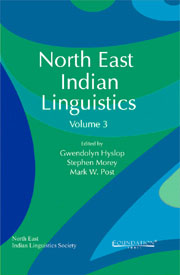7 - Nominalization and Related Phenomena in Marma
from Tibeto-Burman Nominalization
Published online by Cambridge University Press: 26 October 2011
Summary
Introduction
Marma is a dialect of Arakanese, a Southwestern variety of Burmese. It is spoken mainly in the Chittagong Hill Tracts (henceforth CHT), Bangladesh, where the population of Marma speaking people is 154,216 (1991 Census). In India, Marma is commonly known as Mogh and the corresponding population is 30,559 (2001 Census). There are hardly any linguistic reports on Marma/Mogh, except for Konow (1903), Bernot (1958; 1966), Huziwara (2003) and Maggard et al. (2007).
Marma has 7 vowels /a, e, i, ɔ, o, u, ə, 27 syllable-initial consonants /p, ph [ph], b, t, th [th], d, c[tc], ch[tch], j[dz], k, kh [kh], g, m, hm, n, hn, ŋ (which also occurs as a syllable final), hŋ, l, hl, r, hr, y, w, θ, ∫, h/ and one syllable-final consonant /?/ with four distinctive tones: the high tone is marked with an acute accent; the rising tone, with a hacek; the stop tone, with a word-final glottal stop; and the low tone is not marked.
The general grammatical information of Marma is as follows. Lexemes are classified into nouns, verbs and particles. Adjectives occur as a subclass of verbs; adverbs, as a subclass of nouns. The most frequent word order in a sentence is SOV, although arguments may occur before or after the predicate, depending on context. Marma has agglutinative morphology, predominantly using suffixes. Temporal/procedural setting and/or modification is accomplished via combinations of auxiliary verbs and predicate markers. Clause chaining occurs with the aid of various kinds of subordinating/converb-forming markers.
- Type
- Chapter
- Information
- North East Indian Linguistics , pp. 105 - 119Publisher: Foundation BooksPrint publication year: 2011



